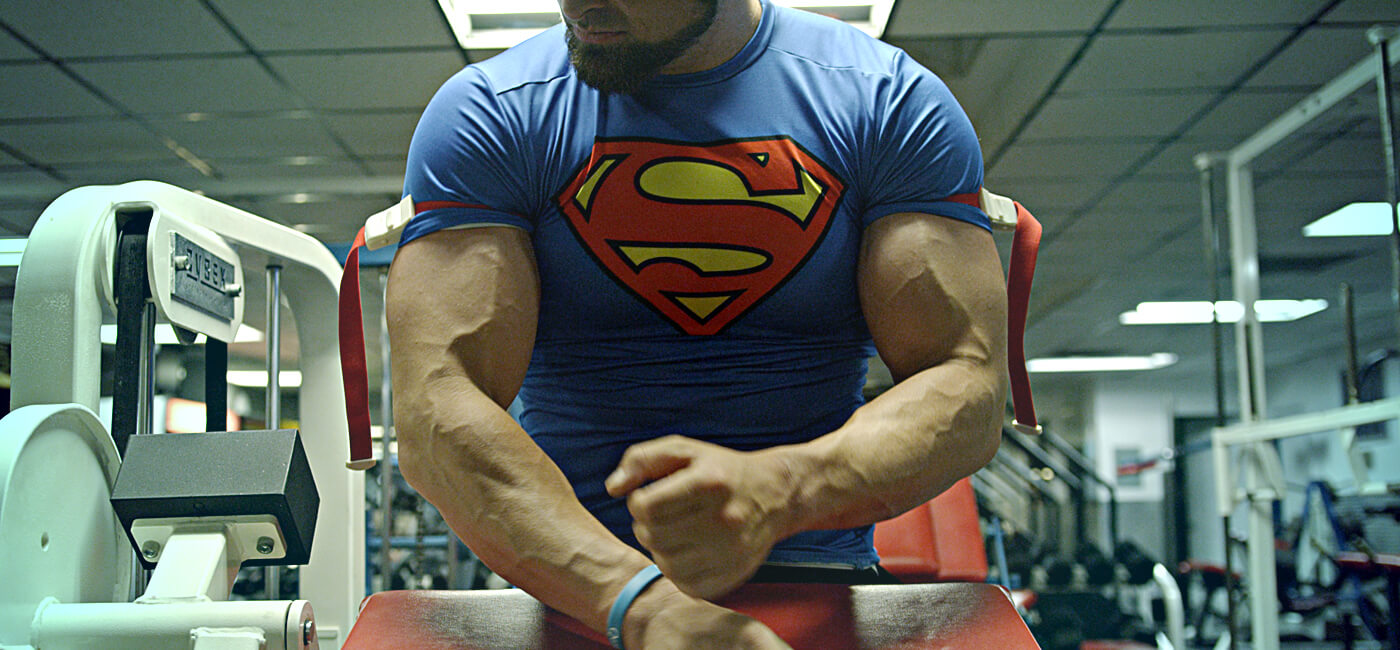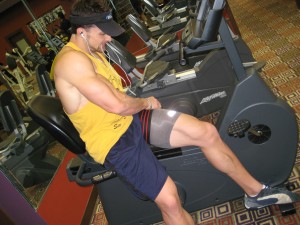“God gave men both a penis and a brain, but unfortunately not enough blood supply to run both at the same time.”
-Robin Wiliams
We all know that blood is vital to support life and various other ‘systems’ as so eloquently stated by Mr. Williams. Blood is responsible for the transport of oxygen, nutrients, and many other molecules crucial for sustained life. Most bodybuilders will also tell you that blood is important for gaining muscle, blood flow to be more specific. Not surprisingly, an entire category of supplements has emerged in the past decade, focused on increasing blood flow and thus purporting to enhance anabolism. But what if I told you that the opposite may be true? What would you say if I told you that occluding blood flow to muscles can have an anabolic effect? You would probably tell me I’m not getting enough blood flow to my brain but you would be wrong. Blood Flow Restriction (BFR) training has years of research to support its effectiveness and in this article I will explain what it is and how to use it to augment your training.
What is Blood Flow Restriction Training?
Quite simply, BFR training involved restricting the venous return of blood flow from the muscle. The goal is not to restrict blood flow to the muscle, but instead prevent blood flow return from the muscle, i.e. you do NOT want to restrict the arterial blood flow to the muscle, only the venous return from the muscle, causing the blood to pool in the muscle. This is accomplished by use of a blood pressure cuff or perhaps more practically using knee wraps tightly secured around the limb(s). For example, to use BFR on arm muscles you would tightly secure a cuff or cloth knee wraps as close to the shoulder as possible. This will restrict blood flow return from the arms and cause the blood to pool.
What is so great about it?
Blood Flow Restriction training when performed properly allows one to use much lower weights than normal training protocols and still achieve sizable anabolic training responses. In fact, occlusion training can increase muscle size and strength using training loads as light as 20% of a 1 rep max (1)! This is especially useful for individuals who individuals who are injured and can only use very light weights or for trainers who are undergoing a deload phase in their training cycle. BFR training allows you to still make gains using light weights while giving your joints, ligaments, and tendons a break from heavy lifting.
How does it work?
BFR training induces an anabolic response through various pathways perhaps the most important of which is by preferentially targeting the large fast twitch muscle fibers. Fast twitch fibers are the biggest muscle fibers and have the most potential for growth. These fibers are recruited last during contractions and are mostly anaerobic (don’t use oxygen) whereas the smaller slow twitch fibers are recruited first during contractions and are aerobic (use oxygen). Slow twitch fibers have a much smaller potential for growth compared to fast twitch fibers. BFR training restricts blood flow to muscles, pre-fatiguing the slow twitch fibers and forcing the anaerobic fast twitch fibers to handle the load even at low intensities (2)! Metabolically, your muscle is getting a similar effect to lifting heavy loads but using much lighter weights. Not only does occlusion training preferentially activate fast twitch muscle fibers, it has been shown to cause a fiber type shift from slow to fast, thus increasing the potential for muscular growth and size (3)!
Metabolic by-product accumulation is primary mechanism by which occlusion training produces hypertrophy. These metabolic by-products would normally be ‘washed out’ by normal blood flow, but occlusion allows them to accumulate near the muscle. Lactate accumulation in particular seems to have an effect, presumably by increasing growth hormone (GH) concentrations (4-5). In fact, one study found that BFR training caused a GH increase 290 times above baseline (4)! This is a twofold greater increase in GH than what is produced by normal heavy resistance training (6).
If those reasons weren’t convincing enough to try occlusion training, consider that it has also been shown to increase muscle protein synthesis, mTOR signaling, and the expression of NOS-1 which has been shown to increase muscle growth through increased satellite cell activation (7-9). Perhaps even more impressive, BFR training has been demonstrated to reduce myostatin concentrations (9)! For those of you who have been living under a rock for the better part of the last decade, myostatin is a big time inhibitor of muscle growth and is thought to limit the muscle potential of muscle gain. Perhaps occlusion training may be able to increase the overall potential of muscle gain through slow to fast fiber shifts and reductions in myostatin!
So are you saying we should use Blood Flow Restriction Training instead of normal heavy training?
BFR isn’t a replacement for heavy training, it is a supplement. It is also very useful for people who can’t train heavy due to injury or deloading. However, occlusion provides several long term benefits that regular heavy training doesn’t including slow to fast fiber transitions and a greater hormonal response.
Practical application?
Before proceeding further, please keep in mind that BFR training is very difficult even though the loads are very light. It is easily the most painful form of training I have ever performed. As always, before starting any kind of new training protocol, you should talk with a medical professional. BFR can be performed for the thighs, calves, upper arms, and forearms using a blood pressure cuff or tightly wrapped knee wraps (more practical). To occlude the thighs and upper arms, wrap at approximately 70% of maximum tightness around the uppermost part of the muscles. To occlude the calves or forearms wrap at approximately 70% of maximum tightness just below the knee or elbow.
Perform 3-5 sets to muscular failure with 20-50% of your 1 rep max on a given exercise with the muscle occluded the entire time. Rest periods should be 30-60 seconds between sets. After the final set remove the wraps and restore blood flow to the muscle. A word of advice, be prepared for a lot of pain and if you do not find yourself in excruciating pain, the odds are the wraps are not tight enough. Try blood flow restriction training and take your training to another hypertrophic dimension!
References
1) Loenneke JP and Pujol TJ. The Use of Occlusion Training to Produce Muscle Hypertrophy. Strength & Conditioning Journal. 31(3): 77-84, June 2009.
2) Takarada Y, Takazawa H, Sato Y, Takebayashi S, Tanaka Y, and Ishii N. Effects of resistance exercise combined with moderate vascular occlusion on muscle function in humans. J Appl Physiol 88: 2097–2106, 2000.
3) Kawada S and Ishii N. Changes in skeletal muscle size, fiber-type composition and capillary supply after chronic venous occlusion in rats. Acta Physiol 192: 541–549, 2008.
4) Takarada Y, Nakamura Y, Aruga S, Onda T,Miyazaki S, and Ishii N. Rapid increase in plasma growth hormone after low-intensity resistance exercise with vascular occlusion. J Appl Physiol 88: 61–65, 2000.
5) Takano H, Morita T, Iida H, Asada K, Kato M, Uno K, Hirose K, Matsumoto A, Takenaka K, Hirata Y, Eto F, Nagai R, Sato Y, and Nakaajima T. Hemodynamic and hormonal responses to a short-term low-intensity resistance exercise with the reduction of muscle blood flow. Eur J Appl Physiol 95: 65–73, 2005.
6) Kraemer W, Marchitelli L, Gordon S, Harman E, Dziados J, Mello R, Frykman P, McCurry D, and Fleck S. Hormonal and growth factor responses to heavy resistance exercise protocols. J Appl Physiol 69: 1442–1450, 1990.
7) Fujita S, Abe T, Drummond M, Cadenas J, Dreyer H, Sato Y, Volpi E, and Rasmussen B. Blood flow restriction during low-intensity resistance exercise increases S6K1 phosphorylation and muscle protein synthesis. J Appl Physiol 103: 903–910, 2007.
8) Anderson J. A role for nitric oxide in muscle repair: nitric oxide-mediated activation of muscle satellite cells. Mol Biol Cell 11: 1859–1874, 2000.
9) Kawada S and Ishii N. Skeletal muscle hypertrophy after chronic restriction of venous blood flow in rats. Med Sci Sports Exerc 37: 1144–1150, 2005.


